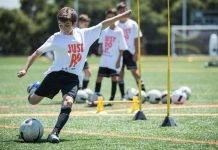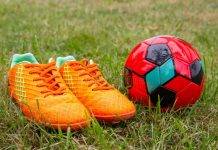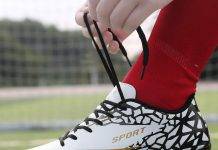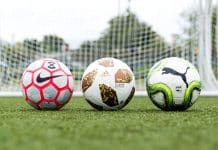Soccer cleats are the ultimate footwear for any serious athlete on the field. But when it comes to choosing the right pair, some may wonder if there’s a difference between boys and girls soccer cleats. Do male and female soccer players need different types of cleats? In this article, we will explore the potential differences between boys and girls soccer cleats and shed light on whether or not it truly matters when it comes to performing at the top of your game.
Design Differences
Review contents
Foot Shape and Size
When it comes to design differences between boys and girls soccer cleats, one key factor to consider is foot shape and size. Generally, boys tend to have wider and larger feet compared to girls. As a result, boys’ soccer cleats are typically designed with a wider toe box to accommodate their broader feet. On the other hand, girls’ soccer cleats are often crafted with a narrower profile to better fit their slimmer feet. It’s essential to find cleats that match the shape and size of your feet to ensure optimal comfort and performance on the field.
Narrowing of the Heel
Another design difference between boys and girls soccer cleats lies in the narrowing of the heel. Boys’ cleats typically have a wider heel section, providing enhanced stability and support during quick movements and changes in direction. In contrast, girls’ cleats often feature a narrower heel design, offering a more snug fit and improved agility. The variation in the heel design aims to cater to the distinct biomechanics and movement patterns between boys and girls during soccer gameplay.
Color and Style
While not directly related to performance, color and style options in soccer cleats do tend to differ between boys and girls. Boys’ soccer cleats often feature bold and vibrant colors, including shades of blue, red, and black, along with dynamic patterns and aggressive designs. On the other hand, girls’ soccer cleats commonly come in a broader range of colors, including pastels, pinks, and purples, sometimes incorporating floral or feminine patterns. These design choices cater to personal preferences and allow players to showcase their unique style on the field.
Functional Differences
Traction and Stud Configuration
The functional differences between boys and girls soccer cleats are primarily centered around factors that affect performance. Traction and stud configuration are crucial in providing grip and stability on various playing surfaces. Boys’ soccer cleats often feature a more aggressive stud configuration, with robust and longer studs designed to dig into the ground and provide superior traction on soft or wet surfaces. In contrast, girls’ soccer cleats may have a slightly less aggressive stud pattern, focusing on versatility and performance on both natural grass and artificial turf.
Support and Padding
Both boys’ and girls’ soccer cleats prioritize support and padding in their design, but the emphasis may vary. Boys’ cleats generally offer more support around the ankle area, providing added stability and protection against possible injuries. Girls’ cleats, on the other hand, may prioritize padding and cushioning in the forefoot region, enhancing comfort and reducing the impact on the foot during gameplay. The varying levels of support and padding aim to cater to the specific needs and preferences of male and female players.
Weight and Flexibility
Weight and flexibility are essential functional differences between boys’ and girls’ soccer cleats. Boys’ cleats often tend to be slightly heavier, as they prioritize durability and added protection due to the physicality of the game. In contrast, girls’ cleats are typically lighter and more flexible, allowing for greater agility and maneuverability on the field. The variations in weight and flexibility aim to optimize performance and minimize fatigue, considering the differing playing styles and physical demands of boys and girls in soccer.
Size and Fit
Size Range
Finding the perfect fit is crucial for both boys and girls when it comes to soccer cleats. Brands generally offer a diverse size range for both genders, ensuring that players of all ages and sizes can find suitable options. Boys’ soccer cleats generally have a broader size range, accommodating their larger feet, while girls’ soccer cleats cover a narrower size range to suit their smaller foot sizes. It’s essential to refer to the brand’s sizing charts and try on different sizes to find the right fit, as it directly impacts performance and comfort on the field.
Width Options
In addition to size availability, both boys and girls soccer cleats often offer width options to cater to different foot widths. While boys’ cleats generally come in wider options to accommodate their broader feet, girls’ cleats provide narrower widths for those with slimmer feet. Having width options ensures a better fit and prevents discomfort or potential injuries caused by a loose or tight shoe. Players should consider their specific foot width and test different options to find the most suitable cleats for their needs.
Price Range
Boys’ Soccer Cleats Price Range
The price range for boys’ soccer cleats can vary depending on various factors, including brand reputation, materials used, and additional features. Generally, boys’ soccer cleats are available at a wide range of price points, starting from more affordable options at around $30 to high-end professional-grade cleats that can cost upwards of $200. The price range allows players and parents to choose cleats that fit their budget while still meeting their performance and quality requirements.
Girls’ Soccer Cleats Price Range
Similar to boys’ soccer cleats, the price range for girls’ cleats varies based on brand, materials, and features. There are girls’ soccer cleats available at various price points, starting from around $30 for budget-friendly options and going up to $200 or more for premium models. The range ensures that players and parents have options to suit their financial constraints while still providing reliable and performance-enhancing cleats for girls to excel on the soccer field.
Availability
Popular Brands for Boys’ Soccer Cleats
There are several popular brands that specialize in boys’ soccer cleats, offering a wide range of options to cater to the different needs and preferences of players. Some of the top brands known for their quality and innovative designs in boys’ soccer cleats include Adidas, Nike, Puma, Under Armour, and New Balance. These brands are renowned for their commitment to providing comfortable, durable, and performance-enhancing cleats for boys of all ages and skill levels.
Popular Brands for Girls’ Soccer Cleats
When it comes to girls’ soccer cleats, there are various reputable brands that offer quality options designed specifically for female players. Adidas, Nike, Puma, Under Armour, and New Balance also rank among the top brands for girls’ soccer cleats. These brands understand the unique characteristics and needs of female players and strive to create cleats that offer the perfect blend of style, comfort, and performance. They are well-known for their attention to detail and commitment to providing reliable and high-quality soccer cleats for girls.
Unisex Options
In recent years, there has been a growing trend toward unisex soccer cleats, which come in sizes that can accommodate both boys and girls. Unisex options offer a more inclusive approach, allowing players to choose cleats based on their specific preferences rather than gendered designs. These cleats often incorporate neutral color palettes and versatile designs, appealing to those who want a more gender-neutral or personalized style. Unisex soccer cleats provide flexibility and allow players to select cleats based on fit and features rather than traditional gender norms.
Durability
Material Quality
Durability is an essential factor to consider when investing in soccer cleats, regardless of gender. Boys’ soccer cleats often prioritize robust and durable materials to withstand the physical demands and rough nature of the game. They are typically constructed with high-quality synthetic leather or synthetic materials that are resistant to abrasion and provide long-lasting performance. Girls’ soccer cleats also prioritize durability, although they may be slightly lighter in weight. These cleats often utilize synthetic materials and innovative construction techniques to ensure long-term use, even in rigorous playing conditions.
Intended Playing Surface
Another aspect to consider when assessing durability is the intended playing surface. Soccer cleats are designed to perform optimally on specific playing surfaces, such as natural grass, artificial turf, or indoor courts. Boys’ and girls’ soccer cleats typically have models specifically tailored for different playing surfaces. Choosing the right cleats for the playing surface helps maintain their durability and ensures maximum performance. Wearing cleats designed for a different surface than the one being played on can lead to premature wear and tear, reducing their overall lifespan.
Expected Lifespan
The expected lifespan of soccer cleats can vary depending on several factors, including frequency of use, playing conditions, and how well they are cared for. Generally, both boys’ and girls’ soccer cleats should last for a full season of play, assuming they are of good quality and receive appropriate maintenance. However, it’s essential to monitor the cleats’ condition, such as checking for any signs of excessive wear, loose studs, or damaged stitching, as these may indicate the need for a replacement. Proper care, such as regular cleaning and air-drying, can also contribute to prolonging the lifespan of soccer cleats.
Safety Concerns
Ankle Support
Ankle injuries are a common concern in soccer, and the design of soccer cleats plays a crucial role in addressing this issue. Boys’ soccer cleats often emphasize ankle support, featuring higher collars or extra padding around the ankle area to provide stability and reduce the risk of sprains or twists. Girls’ soccer cleats also prioritize ankle support, although the design may be slightly different to cater to the anatomical differences of their feet. It’s important for both boys and girls to choose cleats that offer adequate ankle support to ensure safety and reduce the chances of potential injuries.
Protection from Impact
During intense soccer matches, players frequently encounter impacts, whether from collisions with other players or when coming into contact with the ball. Soccer cleats can contribute to protecting the feet from such impacts. Boys’ soccer cleats often incorporate additional padding or cushioning in the forefoot and midfoot regions to absorb impact and reduce discomfort. Girls’ soccer cleats also focus on protecting the feet, typically offering sufficient padding in key areas while maintaining a lightweight design. Choosing cleats that provide adequate protection from impact helps prevent injuries and allows players to play with confidence.
Injury Prevention
Injury prevention is a top priority for both boys and girls in soccer. Aside from ankle support and protection from impact, soccer cleats can contribute to injury prevention through their overall design. Cleats that offer a snug fit, proper traction, and stability help reduce the risk of falls, slips, and incorrect foot placements. In addition, cleats that prioritize flexibility and natural foot movement enable better biomechanics, reducing strain on the muscles and ligaments. By selecting cleats that prioritize injury prevention, players can focus on their performance and enjoy the game without unnecessary risks.
Player Preferences
Color Options
Personal style and individual preferences play a significant role in cleat selection for both boys and girls. Boys’ soccer cleats often feature bold and vibrant colors, such as shades of blue, red, and black, reflecting a more aggressive and dynamic aesthetic. Girls’ soccer cleats, on the other hand, offer a broader range of color options, including pastels, pinks, and purples, as well as the potential for floral patterns or other feminine designs. The availability of diverse color options allows players to express their personality and showcase their unique style on the soccer field.
Design Features
In addition to color options, design features also influence the preferences of boys and girls when selecting soccer cleats. Boys’ soccer cleats often incorporate sleek, aggressive designs that exude power and speed. These cleats may have more prominent branding elements and dynamic patterns to enhance their visual impact. On the other hand, girls’ soccer cleats often feature more delicate and elegant designs, with attention to details such as intricate stitching or refined aesthetics. The variation in design features allows players to choose cleats that resonate with their personal taste and reflect their individual playing style.
Buying Considerations
Player’s Age and Skill Level
When buying soccer cleats, it’s essential to consider the player’s age and skill level. Younger players may require more affordable options, as their feet are still growing, and they may outgrow their cleats quickly. As players progress in skill level, they may benefit from advanced features and technologies that enhance performance. Evaluating the player’s age, growth rate, and skill level helps determine the appropriate cleats that will provide the necessary support, comfort, and performance benefits at each stage of their soccer journey.
Playing Surface
Consideration of the playing surface is essential when purchasing soccer cleats, as it directly impacts their effectiveness and durability. Players who primarily play on natural grass would benefit from cleats with longer, more aggressive studs to provide optimal traction on the softer ground. Those who play on artificial turf or indoor surfaces may require cleats with shorter, more numerous studs or even flat surfaces to ensure stability and prevent injury. Determining the primary playing surface allows players to choose the most suitable cleats that maximize their performance and minimize the risk of accidents.
Budget Constraints
Budget is another crucial consideration when buying soccer cleats. Cleats are available at various price points, allowing players and parents to find options that fit their financial constraints. While premium cleats often offer advanced technologies and superior performance, there are also budget-friendly options that deliver reliable performance and durability. It’s essential to strike a balance between budget and quality, ensuring that the chosen cleats meet the necessary performance and safety requirements while remaining within the allocated budget.
Myth vs Reality
The Myth of Gender-Specific Soccer Cleats
One prevalent myth in the soccer community is the belief that soccer cleats are purely gender-specific. Although there are design differences between boys and girls soccer cleats, it’s important to recognize that these variations primarily cater to biomechanical and aesthetic preferences rather than strict gender guidelines. Many brands now offer unisex options or provide cleat designs that can accommodate players of any gender, considering personal style and preferences. The myth of gender-specific soccer cleats is gradually being dispelled as inclusivity and individuality become more valued in the soccer industry.
Gender Stereotypes and Marketing
Another aspect related to the myth of gender-specific soccer cleats is the influence of gender stereotypes in marketing. Historically, soccer cleat advertisements have reinforced gender stereotypes, portraying boys’ cleats in more aggressive and powerful contexts, while girls’ cleats have been associated with softer and more feminine imagery. However, the soccer industry is increasingly challenging these stereotypes by promoting gender neutrality and inclusivity in their marketing campaigns. Brands are acknowledging that players’ abilities and preferences should dictate cleat choices, rather than conforming to societal expectations or perceived gender norms.





































